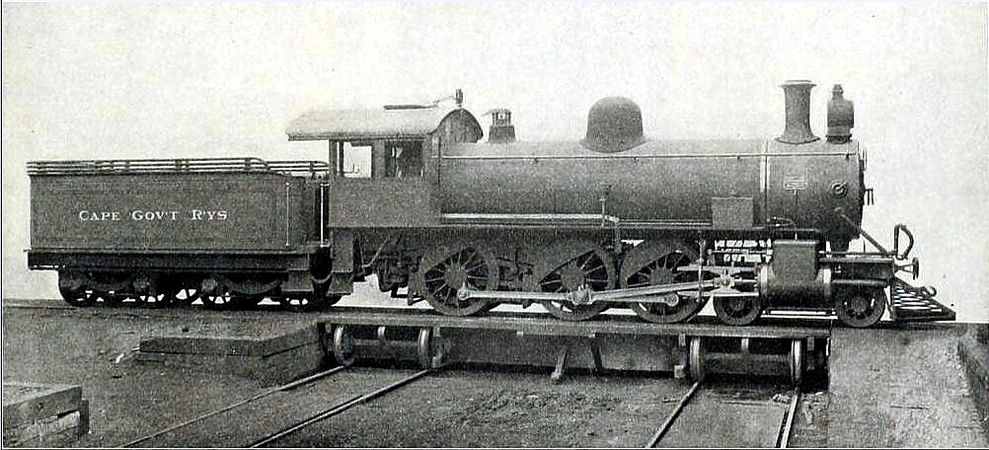South African Class 6G 4-6-0
| CGR 6th Class 4-6-0 1901 Schenectady South African Class 6G 4-6-0 | |||||||||||||||||||||||||||||||||||||||||||||||||||||||||||||||||||||||||||||||||||||||||||||||||||||||||||||||||||||
|---|---|---|---|---|---|---|---|---|---|---|---|---|---|---|---|---|---|---|---|---|---|---|---|---|---|---|---|---|---|---|---|---|---|---|---|---|---|---|---|---|---|---|---|---|---|---|---|---|---|---|---|---|---|---|---|---|---|---|---|---|---|---|---|---|---|---|---|---|---|---|---|---|---|---|---|---|---|---|---|---|---|---|---|---|---|---|---|---|---|---|---|---|---|---|---|---|---|---|---|---|---|---|---|---|---|---|---|---|---|---|---|---|---|---|---|---|---|
 Ex CGR 6th Class no. 263, SAR Class 6G no. 607 | |||||||||||||||||||||||||||||||||||||||||||||||||||||||||||||||||||||||||||||||||||||||||||||||||||||||||||||||||||||
| |||||||||||||||||||||||||||||||||||||||||||||||||||||||||||||||||||||||||||||||||||||||||||||||||||||||||||||||||||||
| |||||||||||||||||||||||||||||||||||||||||||||||||||||||||||||||||||||||||||||||||||||||||||||||||||||||||||||||||||||
| |||||||||||||||||||||||||||||||||||||||||||||||||||||||||||||||||||||||||||||||||||||||||||||||||||||||||||||||||||||
| |||||||||||||||||||||||||||||||||||||||||||||||||||||||||||||||||||||||||||||||||||||||||||||||||||||||||||||||||||||
| The 2nd coupled axle had flangeless wheels | |||||||||||||||||||||||||||||||||||||||||||||||||||||||||||||||||||||||||||||||||||||||||||||||||||||||||||||||||||||
The South African Railways Class 6G 4-6-0 of 1901 was a steam locomotive from the pre-Union era in the Cape of Good Hope.
In 1901, eight redesigned 6th Class 4-6-0 steam locomotives were placed in service by the Cape Government Railways. In 1912, when they were assimilated into the South African Railways, they were renumbered and designated Class 6G.[1][2][3]
Manufacturer
[edit]The original Cape 6th Class locomotive was designed at the Salt River works of the Cape Government Railways (CGR) in 1893, at the same time as the 7th Class.[1]
Three new versions of the 6th Class locomotive entered service on the CGR in 1901, two American-built and one British-built. Of the two American-built versions, one was designed and built by the Schenectady Locomotive Works to the specifications of the CGR locomotive department. They were consequently somewhat different in appearance from the earlier Cape 6th Class locomotives. Eight locomotives were built and delivered, numbered in the range from 262 to 269 and allocated to the Western System.[1][4]
Characteristics
[edit]While these engines were also built on bar frames like the previous two 6th Class versions, they were slightly larger, with larger boilers and with 17+1⁄2 inches (444 millimetres) diameter cylinders compared to the 17 inches (432 millimetres) diameter cylinders of all earlier 6th Class locomotives. Like the two Class 6F locomotives, a visually obvious distinguishing feature was their higher mounted running boards without the need for coupled wheel fairings.[1][4][5]
The locomotive was equipped with Richardson balanced slide valves. The boiler barrel and the outside of the firebox were of Coatesville steel. The boiler feed was by two Cape pattern Gresham & Craven's no. 8 injectors, while the engine used Gresham & Craven's patent sanding gear and a Nathan no. 8 double sight feed cylinder lubricator. It had steam brakes on two pairs of coupled wheels, while the Type WE tender was equipped with a vacuum brake for itself and the train. The whistles were one 3 inches (76 millimetres) and one 4 inches (102 millimetres) Star Chime no. 3 types.[5]
The firebox was 95 inches (2,413 millimetres) long, 28+1⁄2 inches (724 millimetres) wide, 62+1⁄2 inches (1,588 millimetres) deep in front and 48+1⁄2 inches (1,232 millimetres) deep at the back. The firebox itself was of copper, with a rocking style firegrate and a hopper-type ash pan.[5]
The smokebox was equipped with openings on its sides near the front, with covers which each had a handle by which it could be opened with a half turn to give direct access to the inside of the smokebox. This was most likely to facilitate cleaning of the spark arrestor screens to overcome clogging without having to open the smokebox door.
Class 6 sub-classes
[edit]When the Union of South Africa was established on 31 May 1910, the three Colonial government railways (CGR, Natal Government Railways and Central South African Railways) were united under a single administration to control and administer the railways, ports and harbours of the Union. Although the South African Railways and Harbours came into existence in 1910, the actual classification and renumbering of all the rolling stock of the three constituent railways were only implemented with effect from 1 January 1912.[2][6]
When these eight locomotives were assimilated into the South African Railways (SAR) in 1912, they were renumbered in the range from 606 to 613 and designated Class 6G.[2][4][7]
The rest of the CGR’s 6th Class locomotives, together with 6th Class locomotives which had been inherited from the Oranje-Vrijstaat Gouwerment-Spoorwegen (OVGS) via the Imperial Military Railways (IMR) and the Central South African Railways (CSAR), were grouped into thirteen more sub-classes by the SAR. The 4-6-0 locomotives became SAR Classes 6, 6A to 6F, 6H and 6J to 6L, the 2-6-2 locomotives became Class 6Y and the 2-6-4 locomotives became Class 6Z.[4][7]
Service
[edit]The Class 6 series of locomotives were introduced primarily as passenger locomotives, but when the class became displaced by larger and more powerful locomotive classes, it literally became a Jack-of-all-trades. It went on to see service in all parts of the country, except in Natal, and was used on all types of traffic.[1]
The Class 6G remained in service for sixty years, the last one being withdrawn from service at East London in 1961.[3]
Illustration
[edit]-
Schenectady works picture of the Class 6G
References
[edit]- ^ a b c d e Holland, D.F. (1971). Steam Locomotives of the South African Railways. Vol. 1: 1859–1910 (1st ed.). Newton Abbott, England: David & Charles. pp. 48, 56. ISBN 978-0-7153-5382-0.
- ^ a b c Classification of S.A.R. Engines with Renumbering Lists, issued by the Chief Mechanical Engineer’s Office, Pretoria, January 1912, pp. 8, 12, 14, 32 (Reprinted in April 1987 by SATS Museum, R.3125-6/9/11-1000)
- ^ a b Paxton, Leith; Bourne, David (1985). Locomotives of the South African Railways (1st ed.). Cape Town: Struik. p. 43. ISBN 0869772112.
- ^ a b c d South African Railways and Harbours Locomotive Diagram Book, 2’0” & 3’6” Gauge Steam Locomotives, 15 August 1941, as amended
- ^ a b c "Schenectady Ten Wheel Locomotives for Cape Government Railways". Railway and Locomotive Engineering – A Practical Journal of Railway Motive Power and Rolling Stock. 13 (3): 131–132. March 1901. Retrieved 23 December 2012.
- ^ The South African Railways - Historical Survey. Editor George Hart, Publisher Bill Hart, Sponsored by Dorbyl Ltd., Published c. 1978, p. 25.
- ^ a b Holland, D. F. (1972). Steam Locomotives of the South African Railways. Vol. 2: 1910-1955 (1st ed.). Newton Abbott, England: David & Charles. p. 138. ISBN 978-0-7153-5427-8.

